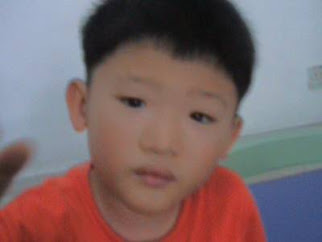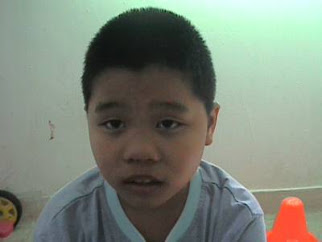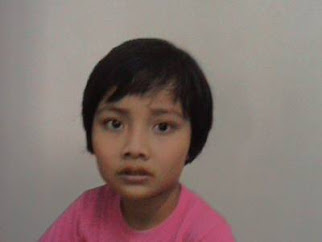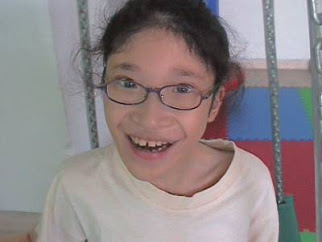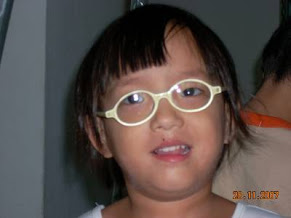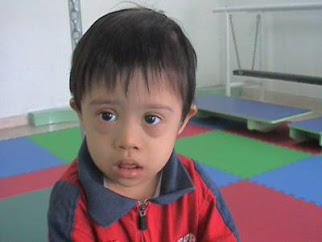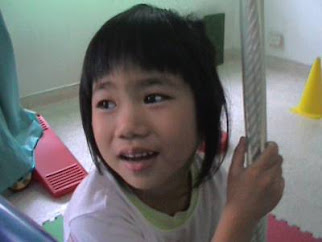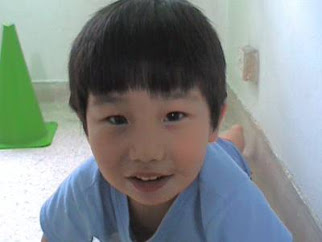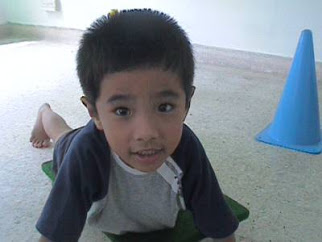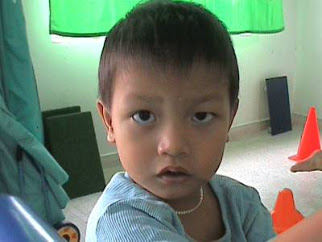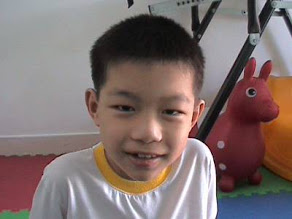Mr. Wong Shyh Shyan (the director of SI World) has implemented sensory integration therapy in Malaysia for 12 years and has earned his reputation through thousands of testimonials:
ChongA 8-year-old boy with Autism who has been with us for 6 months * Result may vary to different people
|
BEFORE• Unable to keep still – always moved around and difficult to get him to stay at one place;
• Always jumping and tiptoeing even when walking; • Body was very stiff and difficult to get him relaxed; • Afraid of plants around him – didn’t even dare to sweep or touch them; • Poor balancing and body coordination; • Very afraid of narrow corridors; • Very little verbal communication with others. AFTER• Body is less tense and more relaxed;
• Able to walk properly without tiptoeing if reminded (sometimes) although the problem still exists; • Able to do IQ puzzles quite independently; • Plants do not disturb him anymore; • Better balancing and can coordinate his body more smoothly; • Shows initiative to talk, therefore better verbal communication (can be better understood); • More curious and looked at everything when go shopping; • Can accept that there are certain things that he cannot consume; • Less afraid of narrow corridors; • More capable of taking care of himself – took a tissue paper to wipe off blood from a mosquito bite; • Smarter – knows to use tricks to get what he wants e.g. asked mother to take water for him so that he could go and take the things the mother disallowed him to play. |
BryanA 10-year-old boy with Autism who has been with us for 6 months * Result may vary to different people
|
BEFORE• No spontaneous response for language;
• Laughed for no reason; • Often self-induced vomiting; • Visual tracking – moderate; • Phobia to hair cutting because of 1 incident; • Repeated ‘yes’ or ‘no’ when asked a same question; • Not able to follow multi-part instructions. AFTER• More words and sentences;
• More observant; • Has more initiative to think and do his task; • Seldom laughs unreasonably; • Stopped self-induced vomiting; • Visual tracking improved because able to hit the moving ball better; • Willing to go for hair cutting again; • Able to answer ‘yes’ or ‘no’ questions more precisely; • Able to follow 2-part instructions better; • Started to sense things he never bothered about before e.g. lighting; • More initiative to communicate e.g. said ‘pain, pain’ when he felt painful. |
NgAn 8-year-old girl with Autism who has been with us for 7 months |
BEFORE• Unable to sit still;
• Made weird noises when asked to do something she didn’t want to; • Would rush when entering centre and threw her bag down; • Poor visual spatial as didn’t know where to start and stop while colouring; • Very passive and refused to do most of the activities. AFTER• Easier to control her discipline;
• Walks into the centre properly and even waits for the therapist to lock the gate first; • Visual spatial improves; • More willing to do the activities; • Tries to communicate by giving the therapist something to show what she wants; • Knows that she should flush the toilet after use; • Fight for a toy with a friend like a normal child; • Able to use her body better as she is able to kick the moving ball. |
JaniceA 12-year-old girl with Cerebral Palsy who has been with us for 6 months * Result may vary to different people
|
BEFORE• Very sensitive to gravity and no initiative to do things;
• Very short attention span and distracted very easily; • No speech at all; • Walked and moved very slowly and awkwardly; • Needed full body support when walking on the balance beam; • Very poor bilateral coordination, couldn’t even hold a ball with two hands; • Very poor fine motor skills and always positioned the thumb wrongly; • Lack of confidence in movement because falling down easily; • Refused to drink plain water almost totally. AFTER• Able to walk on the balance bridge independently;
• Able to get up or down the swing without help; • Able to stand on kneels on the swing; • Able to pick up and transfer beads with tripod grip after some massage; • Walks more smoothly and able to walk up stairs by alternating her legs; • Starts to walk up or down the stairs with only one hand holding the handrail; • Able to balance herself on the balance rocker for 15 minutes without support; • More able to hold things properly (knows how to use her thumbs better); • Less sensitive to gravity and even tries to jump on the trampoline; • More strength in fingers and able to “take off” the vegetable set and zip a bag; • More alert and knows what’s going on around her. She gets ready by taking her bag when her mother is parking ; • Can respond faster by catching the ball thrown to her; • Better attention, therefore performs better during table work time. • Starts to speak certain words e.g. ‘bye-bye’, ‘lion’, ‘purple’ and etc… • Drinks pretty of plain water but some prompting is needed. |
GohA 4-year-old girl with Cerebral Palsy who has been with us for 2 months * Result may vary to different people
|
BEFORE• Afraid of strangers;
• Right limbs were stiff; • Unable to balance well when moving; • Unable to sit upright; • Had lazy eyes; • Coordination of limbs were not good; • Needed help or support when getting up from potty and climbing stairs; • Right hand not much strength. AFTER• Not as afraid of strangers as last time;
• Able to walk well and even starts to run; • Is sitting upright; • No more lazy eyes; • Limbs are more flexible; • Able to grip a pencil better; • Able to climb stairs and get up from potty on her own without support; • More strength in her right hand, therefore able to use it better; • More able to climb up the stairs with alternate legs. |
GerardA 2-year-old boy with Down’s Syndrome who has been with us for 3 months * Result may vary to different people
|
BEFORE• Afraid of staying on a moving object like a swing;
• No initiative to walk and wanted to be carried all the time or creeping around instead of walking; • Preferred throwing things to doing table work properly; • Very stubborn and difficult to be disciplined. AFTER• Able to sit and stand on a moving swing for about ½ hour;
• Able to balance himself better and is able to walk for quite a distance (25 – 30 feet) without any support; • Prefers walking than creeping but will look for support while standing; • Could even stand up by himself on a moving swing by holding the chains; • Started doing some table work although the performance is not stable; • More flexible and more willing to follow instructions. |
ClarissaA 5-year-old girl with Speech-Language Delay & AD/HD who has been with us for 4 months * Result may vary to different people
|
BEFORE• Very active and difficult to calm her down;
• Poor visual-spatial, therefore often put herself in a wrong position and had poor adjustment with spaces; • Poor sense of danger – jumped down from moving swings without notice; • Problem with modulation – got excited very easily; • very disorganized and always didn’t know what she had to do next; • No patience and was rushing all the time; • Always overlooked the details; • Poor body sense and under sensitive to pain; • Poor concept of colors and shapes; • Blurred and couldn’t understand verbal instructions; • Weak bilateral coordination – either hit ball with both hands or right hand but couldn’t hit with alternate hand. AFTER• Calm and steady, therefore able to walk properly, put down her bag and sit down to wait for time/mother;
• More organized – knows what she has to do although still making mistakes; • Would stay still on swings and less worried about her safety; • Not rushing anymore and will wait for her turn; • Better in visual-spatial and has better adjustment when crossing the obstacles; • More aware of her body and feels pain more reasonably; • Starts to understand simple verbal instructions e.g. ‘turn’, ‘take out’, ‘put here’ etc… • Starts to hit ball with alternate hand. |
JeremyA 4-year-old boy with Speech-Language Delay with Autistic Features who has been with us for 6 months * Result may vary to different people
|
BEFORE• Carried some autistic features like little eye contact, always produced nonsense sounds etc…
• Unable to perform most motor tasks without visual cues; • Had difficulty with fine motor coordination; • Needed to keep moving and had a hard time with organized and structured activities; • Afraid to stay on moving objects e.g. swing; • Very little vocabulary and could not complete a nursery rhyme; • Played toys meaninglessly e.g. dropped small items from hands, arranged them vertically or horizontally etc… AFTER• Doesn’t look like an autistic anymore;
• More eye contact and little nonsense sounds; • Able to put things into a bag and zip it up; • Able to imitate 5-6 syllables sentences e.g. ‘I want to come down,’ ‘I want to drink water’; • Able to show his wish e.g. ‘I don’t want,’ 'yes, I want’; • Able to sing a number of songs; • Accepts swinging/moving objects; • Able to catch ball and throw ball properly; • More voluntary interaction with others e.g. says ‘bye-bye’ to a person going out; • Plays toys meaningfully e.g. sorts out colors and shapes. |
SeeA 5-year-old boy with Speech-Language Delay who has been with us for 6 months * Result may vary to different people
|
BEFORE• Speech not of his age level;
• Very impatient; • Poor fine motor skills; • Very sensitive to height and swinging objects; • No confidence; • Lack of discipline; • Got high very easily and simply shouted. • Suspected to be an autistic by a few of related professionals. AFTER• More patience in learning;
• Less active; • Emotionally more stable; • Not as rigid, has more confidence, more adaptive to new things, therefore more willing to try things he used to be scared; • Able to grip a pencil better and color within the lines; • Able to sit still in class and listens to teachers’ instruction. • Confirmed that he is not an autistic. |
BrandonA 3-year-old boy with Speech-Language Delay who has been with us for 2 months * Result may vary to different people
|
BEFORE• Very rigid and no confidence, therefore difficult to accept new activities;
• No discipline and unable to remain seated at 1 place; • Poor fine motor skills; • Not observant. AFTER• More confident and playful, therefore more willing to try new challenges;
• More disciplined and able to remain seated at 1 place; • Fine motor skill has improved; • More observant and begins to see things that he had never realized was there before. |
TeeA 7-year-old boy with Epilepsy who has been with us for 2 months * Result may vary to different people
|
BEFORE• Unable to stay still or remain seated at 1 place;
• Didn’t know how to play, nor have the initiative to move around i.e., always complained of tiredness; • Left hand was much weaker than his right hand; • Needed to have diapers on. AFTER• Able to remain seated to wait for the session to start;
• More initiative to do the activities; • Hands have better strength, therefore able to use his left hand better; • Better balancing and is more energetic; • Table work progresses quite fast and his level has been increasing steadily; • More able to follow verbal instructions; • More vocabulary and speech; • Able to reason out things or situations; • Understands and able to go to toilet to ease himself. |
My Timothy
My Timothy My son, Timothy, was only 1½ year-old at that time. He spoke very few words as compared to his cousin, who was younger than him. He seemed to prefer staying in his own world and was not able to interact well with people around him. Our family doctor had raised his concern and ran some tests when we brought him for vaccination. But nothing conclusive had been established; anyway, the doctor advised us to give him another half a year time to see any changes or improvement on him in the future....
The Growth of My Daughter - Yong Kah Yean
Yong Kah Yean, 3½ year-old
Before
Before
- Delayed language & speech (language & speech remained at 1½ -2 years): able to speak only two-words phrases and keep repeating questions that others asked her
- Lack of concentration: unable to sit still and pay attention to the teachings in the classroom, could not focus and complete the task given
- Poor eye-hand coordination: unable to perform buttoning or unbuttoning action and had difficulty wearing socks
- Poor fine motor skills: result in difficulty in writing, always color beyond the border
- Lack of sense of danger
- Lack of eyes contact
All these cases are individual results and results do vary. Click here to know more >>

